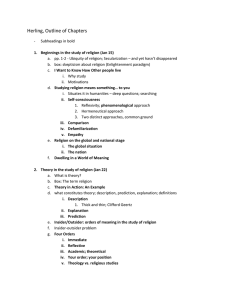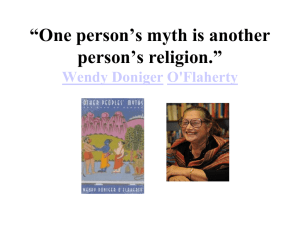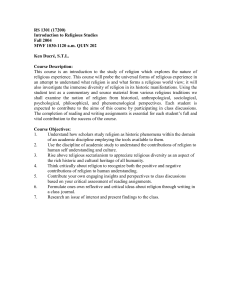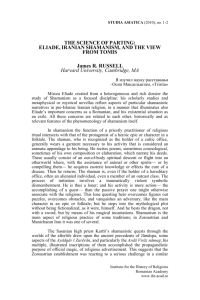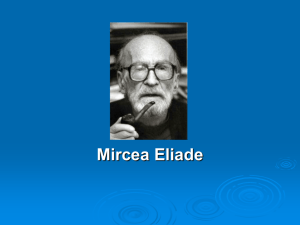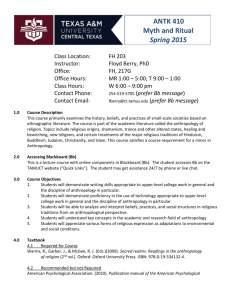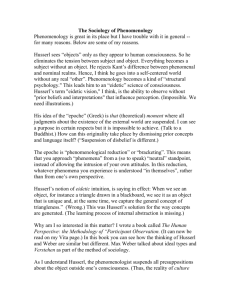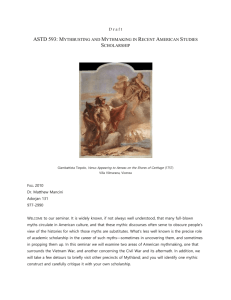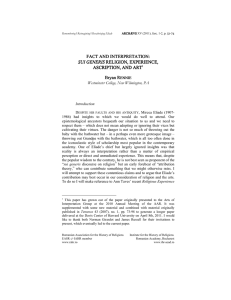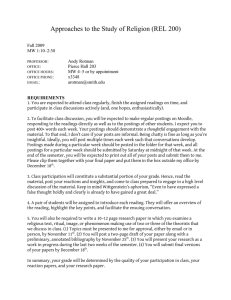Religion Mircea Eliade: ‘Secular mysticism’ and the history of religions ennie ScienceDirect
advertisement
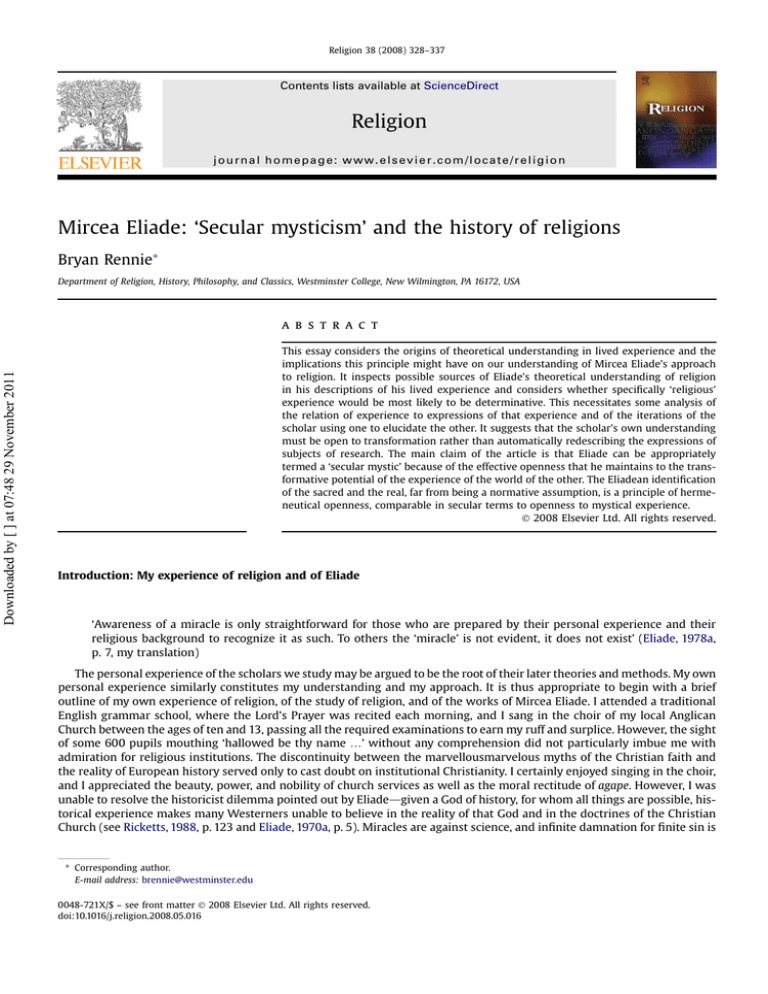
Religion 38 (2008) 328–337 Contents lists available at ScienceDirect Religion journal homepage: www.elsevier.com/locate/religion Mircea Eliade: ‘Secular mysticism’ and the history of religions Bryan Rennie* Department of Religion, History, Philosophy, and Classics, Westminster College, New Wilmington, PA 16172, USA Downloaded by [ ] at 07:48 29 November 2011 a b s t r a c t This essay considers the origins of theoretical understanding in lived experience and the implications this principle might have on our understanding of Mircea Eliade’s approach to religion. It inspects possible sources of Eliade’s theoretical understanding of religion in his descriptions of his lived experience and considers whether specifically ‘religious’ experience would be most likely to be determinative. This necessitates some analysis of the relation of experience to expressions of that experience and of the iterations of the scholar using one to elucidate the other. It suggests that the scholar’s own understanding must be open to transformation rather than automatically redescribing the expressions of subjects of research. The main claim of the article is that Eliade can be appropriately termed a ‘secular mystic’ because of the effective openness that he maintains to the transformative potential of the experience of the world of the other. The Eliadean identification of the sacred and the real, far from being a normative assumption, is a principle of hermeneutical openness, comparable in secular terms to openness to mystical experience. Ó 2008 Elsevier Ltd. All rights reserved. Introduction: My experience of religion and of Eliade ‘Awareness of a miracle is only straightforward for those who are prepared by their personal experience and their religious background to recognize it as such. To others the ‘miracle’ is not evident, it does not exist’ (Eliade, 1978a, p. 7, my translation) The personal experience of the scholars we study may be argued to be the root of their later theories and methods. My own personal experience similarly constitutes my understanding and my approach. It is thus appropriate to begin with a brief outline of my own experience of religion, of the study of religion, and of the works of Mircea Eliade. I attended a traditional English grammar school, where the Lord’s Prayer was recited each morning, and I sang in the choir of my local Anglican Church between the ages of ten and 13, passing all the required examinations to earn my ruff and surplice. However, the sight of some 600 pupils mouthing ‘hallowed be thy name .’ without any comprehension did not particularly imbue me with admiration for religious institutions. The discontinuity between the marvellousmarvelous myths of the Christian faith and the reality of European history served only to cast doubt on institutional Christianity. I certainly enjoyed singing in the choir, and I appreciated the beauty, power, and nobility of church services as well as the moral rectitude of agape. However, I was unable to resolve the historicist dilemma pointed out by Eliadedgiven a God of history, for whom all things are possible, historical experience makes many Westerners unable to believe in the reality of that God and in the doctrines of the Christian Church (see Ricketts, 1988, p. 123 and Eliade, 1970a, p. 5). Miracles are against science, and infinite damnation for finite sin is * Corresponding author. E-mail address: brennie@westminster.edu 0048-721X/$ – see front matter Ó 2008 Elsevier Ltd. All rights reserved. doi:10.1016/j.religion.2008.05.016 Downloaded by [ ] at 07:48 29 November 2011 B. Rennie / Religion 38 (2008) 328–337 329 against reasondespecially considering divine mercy. By the time I was 14, I had quit the choir and severed any ties with institutional religion. It was precisely this inability to understand the religious position that increasingly drew me to religious studies. Religion appeared to me to be so self-evidently incredibledunbelievable almost by definitiondthat I simply could not comprehend how or why anyone ever became involved with it. At that time (the early 1970s) non-Western religion penetrated every level of popular culture. The Beatles visited the Maharishi Mahesh Yogi; devotees of Hare Krishna were everywhere; and any reference to Zen Buddhism seemed a guarantee of literary success. So the inherent difficulties I had with the Christian tradition were further complicated by the irreducible plurality of traditions. All this (and another curious factdno-one else seemed to want to study this phenomenon) made religious studies irresistible to me. My initial experiences as a student of religion at New College, the Faculty of Divinity of the University of Edinburgh and the principal seminary of the Church of Scotland, were disappointing. I was one of only three students who enrolled in the religious studies program in 1973, among several hundred Bachelor of Divinity and pre-ministry students. It seemed that the majority of faculty and students alike were primarily concerned with justifying their own faith by converting anyone who might listen, rather than attempting to improve our understanding of the global phenomenon of religion and religious pluralism. However, this had a rather unexpected salutary side-effect. Since I was under constant pressure from some very eloquent and knowledgeable people, I had to face the very real possibility that I might come to convert. The program at Edinburgh introduced students to adherents of many faiths. Many of them, like many of the lecturers and students at New College, were highly intelligent and admirable people (despite my inability to understand their point of view as anything other than wrong). Having been forced to confront the possibility of my conversion, I had to realize the possibility of conversion to any tradition. It is a matter of fact that inter-cultural conversions do take place. Thus I had to recognize the possibility that I might come to see their point of view as right and become Hindu (like George Harrison), Buddhist (like Gary Schneider), or Muslim (like Yussuf Islam, Muhammad Ali!). Thus an early methodological principle of my own was formed: I studied religion from the point of view of one who accepted as real the possibility of conversion. Yet I did not convert. Even if I had, it could have only been to one tradition (pace Huston Smith), which would not necessarily increase my understanding of the other traditions. The major problem was that I still saw the traditions as fundamentally incredible. When, in my doctoral years, I began a closer study of the works of Mircea Eliade (who was not a particularly celebrated figure in the British academy), I began to glimpse the possibility of a real understandingdan understanding-asrealdof those alternative human positions that were closed to me by the very fact that I occupied my own position. The plainest indication that Eliade approached religion from a point of view at least similar to my own comes in the introduction to The Eliade Guide to World Religions: ‘What is religion? Why do rational, practical people still buy into it?’ (Eliade and Couliano, 1991, p. 1). I hope to answer that question by explaining how Eliade’s thought makes possible an openness to alternative worldviews as having the same basic structure and as being as internally coherent, consistent, and comprehensible as one’s own. I also hope to show how this effectively opens the world of the theorist to the world of the other, and that this makes the epithet of ‘secular mysticism’ particularly appropriate to Eliadean hermeneutics.1 Eliade’s ‘religious’ experiences ‘If the doors of perception were cleansed, everything would appear to man as it is, infinite.’ (William Blake, The Marriage of Heaven and Hell) I have intimated a parallel between Eliade’s historical experience and his understanding of religion. His writing contains descriptions of events resembling the conventional idea of religious experiences. His foray into the realms of tantrism is known from the first volume of his Autobiography, as are the descriptions of childhood experiencesdthe little girl on Strada Mare and the mysterious room that gave access to ‘a fragment of incomparable timeddevoid of duration’ (Eliade, 1981, pp. 196, 4f., 6f.). Fictionalized references to other experiences during and after his stay in Svarga Ashram in Rishikesh can be found in Two Strange Tales (Eliade, 1970adbut see Bordaş, 2007, which questions Eliade’s accuracy). We must ask whether these are reliable records of experience or ex post facto narrations, that is, retrospective attempts to give a structure to Eliade’s understanding of religious experience. Obviously these accounts were all written well after the events: Two Strange Tales (Eliade, 1970b) which includes ‘The Secret of Dr. Honigberger’ and ‘Nights at Serampore’ was written in 1940, and Eliade’s autobiography was not published until 1981dbut the problem is deeper than that. All possible expressions of experience are necessarily distinct from the experience they express. Any hypothesis that relies upon any supposed experience makes possible the sleight of hand against which Robert Sharf warns: ‘The term [experience] is often used rhetorically to thwart the authority of the ‘‘objective’’ or the ‘‘empirical,’’ and to valorize instead the subjective, the personal, the private. . Authorial intent and religious experience both occupy the same highly ambiguous but ultimately unassailable ‘‘ontological space’’’ 1 I am not the first to make this identification of Eliade as a ‘secular mystic’. Ansgar Paus has identified the basis of Eliade’s creative hermeneutics as the Byzantine theory of icons and thus refers to Eliade as ‘a secularized mystic of Byzantine Christianity’ (Eliade, 2006, p. 401). However, my meaning is different from that of Paus. My thanks to Stuart Sarbacker for this observation. 330 B. Rennie / Religion 38 (2008) 328–337 (Sharf, 1998, p. 104). René Descartes in the 17th century notoriously appealed to introspected experience, and Daniel Dennett warns us that: Downloaded by [ ] at 07:48 29 November 2011 perhaps we are just fooling ourselves about the high reliability of introspection, our personal powers of selfobservation of our own conscious minds. Ever since Descartes and his ‘cogito ergo sum,’ this capacity of ours has been seen as somehow immune to error; we have privileged access to our own thoughts and feelings, an access guaranteed to be better than the access of any outsider. (Dennett, 1991, p. 67) Also, the constructive aspect of autobiographical memory has been well attested since F. C. Bartlett introduced this view in 1932 (see also McClelland, 1995 and, for a more accessible introduction, Kotre, 1996). All this serves to cast considerable doubt on the reliability of Eliade’s autobiographical accounts as simply accurate description of events. As scholars researching and reconstructing past events, we must rely on an open-ended, iterative movement between the expressions that constitute our text and our own theoretical reconstruction of the experience that the text supposedly expresses. As our theory changes, so our understanding of the text changes, and this influences further adaptations of the theory until we are satisfied with the fit between the two. As Eliade sought to express his own understanding of experiences that he saw as formative, his understanding of what they formed would influence his understanding and thus his description of the experience. With this in mind, I would like to consider some other statements of Eliade’s which could be seen as formative to his understanding of religion. What is the relationship, and what is revealed by the relationship, between Eliade’s personal (‘religious’) experiences and his understanding of religion? The movement between text and theory is always already underway. Our understanding of what is and what is not ‘religious’ determines what can and what cannot be considered as candidates for religious experience. I contend that it is not so much in startling and extraordinary personal experiences of unnatural or inexplicable events or entities that we find ‘sacred history’ as it is in an uncritical apprehension of some experience (and narratives are experiences) as expressive of the real. The determining antecedents of Eliade’s understanding are to be found less in his own accounts of unusual ‘religious’ experiences, than in those narratives which he simply accepts to be true. I have argued that Eliade’s theoretical position is religious in the sense in which I understand him to use the word, and that this is wholly consistent with his procedural assumptions, since he sees humanity as inherently religious (Rennie, 1996, p. 257). ‘To be, or to become, human means to be religious’ (Eliade, 1969a, preface). Having made such a contention, he cannot be expected to escape his own classification of humanity. Since, as I say, this assumes Eliade to be religious ‘in the sense in which I understand him to take the word’, it is necessary that I clarify precisely what that sense is. For Eliade, religion is the expression of our embodied experience of the world and our constant and ongoing interaction with the reality apprehended in that experience. I have suggested that: religion is the total structure of values held, traditionally transmitted through a cultural matrix of symbol, oral and written narrative, scripture and ritual, and reinforced by mythical rather than by rational means. This structure is dependent upon self-authenticating intuitions of the real, [what Eliade called] hierophanies or revelations apprehended in individual experience . (Rennie, 1996, p. 109) Evidently, the ‘self-authenticating intuitions of the real’ that constitute ‘religious experience’ for Eliade must be further elucidated. ‘In Eliade’s understanding, myth is determined by the prevalent attitude to a narrative. Myth is the narrative which is (either uncritically or with reference to other myths) held to be true, to represent the real, and thus to be exemplary. In Eliadean terms, to be sacred’ (Rennie, 1996, p. 72). This is unavoidably connected to Eliade’s idea of ‘sacred history’, which is the narrative of those factors held to be the explanatory determining antecedents of our lived experience (Rennie, 1996, p. 90). So are there any ‘self-authenticating intuitions of the real’ or narratives which Eliade ‘(either uncritically or with reference to other myths) held to be true, to represent the real, and thus to be exemplary’? Yes. For example, in an article of 1937 in reference to cryptesthesia pragmatica (which Eliade defines as ‘the faculty of certain people to ‘‘see’’ persons, objects, or even whole episodes while touching something carried for a long time in contact with the human body’, Eliade, 2006, p. 28), Eliade insists that: we must ask if such a ‘fluid’ connection between man and objects touched by him is perfectly refuted by human experience, studying this human experience in its broadest extent, and not only on the normal planes. As a matter of fact, we know that this ‘fluid’ link is substantiated also today, in the case of subjects belonging to European and American cultures, and has been examined seriously by Dufay, Azam, Phaneg, Pagenstecher, Prof. Charles Richet, and others. (Eliade, 2006, p. 28) No bibliography accompanies these references to establish that this is, indeed, a ‘matter of fact’. The unquestioning assumption of such ‘knowledge’ as fact by Eliade is apparent. Equally apparent to me is the immediate assumption that I find in myself (and suspect in others), that these studies must be the work of charlatans, dilettantes, or fools. I find that my mind is, without considerable mental effort, automatically closed to the possibility of such a faculty and such a ‘fluid’ connection. Eliade, on the other hand, concludes that ‘certain primitive and folkloric beliefs have concrete experiences as their basis. Far from having been imagined, they express, confusedly and incoherently, certain happenings which human experience accepts within its limits’ (Eliade, 2006, p. 30, emphasis original). In an even earlier essay, Eliade had written that ‘contagious magic is not the creation of a prelogical consciousness, but the codification of frequently-repeated observations: it is a scientific objective truth’ (Eliade, 1927a, p. 3, emphasis original). B. Rennie / Religion 38 (2008) 328–337 331 Eliade points out that: starting from the premise that levitation is impossible since it disregards the laws of gravity, all the secular scholars who have studied the lives of the saints have ascribed no reality to these testimonies. Here we find a grave contradiction of what is called the ‘historicistic spirit of the nineteenth century’ . ‘Historicism’ . bases its understanding of the world on facts, on documents; the great revolution which the ‘historicists’ declare that they have accomplished in the judgement of reality is the primacy of the document. . They do not believe anything not confirmed by the document, and they do not believe the document until it has been subject to ‘textual criticism.’ But there exist a considerable number of ‘documents’ which the historical science of the last century and of our own does not take into account: for instance, the hagiographic documents which refer to the ‘miracles’ of the saints. And it takes no account of them, not because the authenticity of these documents is in doubt, not because textual criticism has demonstrated their uncertainty, but simply because they have to do with miracles, with impossible things. Here we see the contradiction of the ‘historicistic spirit,’ because an historian, who declares himself to be the slave of the document, does not have the right to reject a text for rational, philosophical reasons; this implies an a priori theory of the real which cannot prevail over an historicist without his renouncing his point of departure, the primacy of the document. (Eliade, 2006, p. 32, all emphases original) Downloaded by [ ] at 07:48 29 November 2011 What troubles me most about this is that I find myself doing exactly what Eliade describes. I want to remain open to the documentary evidence, but I find myself already convinced that the documents to which he refers must be redescribed as something other than accounts of perceptions, because they are inconsistent with my own understanding. Eliade, on the other hand, insists, We find it much easier to believe that a ‘primitive’ [his scare quotes] comes to assert the incombustibility of the body by starting from an event which he has witnessed, than to believe that he imagined this thing through who knows what obscure process of the mind. . we have the right to suspect that at the base of other popular beliefs lie concrete facts. (Eliade, 2006, pp. 35–36, emphasis original) The 1937 article continues, ‘if it is true that ethnography and folklore put documents at our disposal having an experiential source, then we have the right to accord some faith to all the beliefs that ethnographers and folklorists collect’ (Eliade, 2006, p. 36). Right or wrong, this seems to be an underlying expectation or assumption, a determining factor in Eliade’s paradigm,2 so to speak, which shapes his analysis of religion. He explains, [o]f course, it is not a matter here of ‘believing’ blindly in all popular legends and superstitions, but of not rejecting them en bloc as delusions of the primitive spirit. Once it has been proven that the biological and physical laws can be suspendeddin levitation and the incombustibility of the human bodydnothing can hinder us from believing that these laws can be suspended in other circumstances: for instance, in the case of the disappearance of the human body. (Eliade, 2006, p. 36) It could certainly be argued that these opinions of Eliade are held to be true uncritically or with reference to other unexamined assumptions. For him they are revelatory of the real, and thus to him they are exemplary. In Eliadean terms, they are mythic, hierophanic, sacred. Oscillation between Eliade’s life experience and his theoretical understanding of religion settles at this point. His apprehension of folkloric accounts of levitation, disappearance, incombustibility, and so on, as communicative of genuine experiences is homologous to his theoretical understanding of the sacred. The experience of folkloric claims as expressions with an experiential basis becomes a central theoretical principledhis ‘sacred/real identity’. (For detailed analysis of the relation of the sacred and the real with supporting argument and evidence, see Rennie, 1996, ch. 2.) Eliade’s equation of the sacred and the real is consistent throughout his work since Cosmical Homology and Yoga, also published in 1937. The sacred/real identity homologizes the sacred of the religious other with the real of the secular self. The apprehension of the reality of any phenomenon in my own experience is homologous to the revelation of the sacred in the world of the believer. They are both hierophanies. In the final analysis, this relativizes both the sacred and the real, but Eliade’s virtue (it is also, in the eyes of his critics, his major vice) was to write in such a way as to allow the absolute nature of the sacred for homo religiosus: it is as real (to them) as reality is (to me). Such thought comes at the cusp of modern and postmodern when ‘reality’ still retains its sense of absolute and independent Being but paradoxically also takes on a sense of relative appearance. The following quotations are, I hope, sufficient to illustrate Eliade’s use of ‘real’ in this two-edged manner. If nothing else, note the repeated use of the indefinite article. ‘[M]an is faced with a reality and a force that belong to some world other than the profane world of which he is himself a part’ (Eliade, 1958, p. 216); ‘the sacred always manifests itself as a reality of a wholly different 2 ‘Paradigms determine large areas of experience’ (Kuhn, 1970, p. 129). One of the reasons why I would concur with Eliade that we are all ‘religious’ is that even scientific paradigms are determined, not by immediate experience of the physical, empirical environment, but by narrated structures communicated to us by our socio-cultural environment. Humans can be human in no other way. A human conditioned only by the natural environment is feral. Downloaded by [ ] at 07:48 29 November 2011 332 B. Rennie / Religion 38 (2008) 328–337 order from ‘‘natural’’ realities’ (Eliade, 1959, p. 10); ‘the sacred is pre-eminently the real, at once power, efficacy, the source of life and fecundity’ (Eliade, 1959, p. 28); ‘it is this experience of the sacred that generates the idea of something which really exists and, in consequence, the notion that there are absolute intangible values which confer a meaning upon human existence’ (Eliade, 1960a, p. 366); the believer ‘always believes that there is an absolute reality, the sacred, which transcends this world but manifests itself in this world, thereby sanctifying it and making it real’ (Eliade, 1960b, p. 202). I pointed out in Reconstructing Eliade that many readers take Eliade either to fail to define the sacred or to identify the sacred with the Judaeo-Christian God or some comparable autonomous ‘transcendent’ being. As we have seen, Eliade does insist that ‘the sacred is pre-eminently the real’. However, he also maintains that any phenomenal entity could be perceived as manifesting the sacred (Eliade, 1958, p. 11). Furthermore, ‘the Sacred’ refers to a ‘mode of experience’, it is ‘a structure of the human consciousness’ (Eliade, 1969a, p. i; 1977, p. 313; 1978b, p, xiii). Certain experiences are apprehended as sacred by the appropriately prepared subject. So all experience of the sacred/real is a subjective experience of the objective world expressed in traditional forms, rather than an unmediated apprehension of an autonomous entity. Most importantly, this denies any privileged or unmediated access to the real. It is the very fact that the sacred/real is expressed in so many forms and that we carry our own inner certainty as to what is and is not ‘real’ that generates so many varied interpretations of Eliade’s thought and also the vivid (but mistaken) impression that he is describing an autonomous, independent entity. I have warned against the tendency to read our own ‘realities’ into Eliade’s real or sacred (Rennie, 1996, p. 20). If the reader assumes Eliade to mean by the sacred or by the real exactly the same thing as the reader, then misunderstanding occurs. Rather, these terms can be read as signifying the intentionality of belief: an almost aesthetic category, like ‘the beautiful’. In that case my own subjective apprehension of reality becomes a common factor that I share with all other humans, a bridge rather than a barrier. (One should never forget that Eliade argued for the ubiquity of homo religiosus and the final impossibility of the entirely ‘secular’ or ‘modern’, supposedly non-religious, human.) In this way an opening is maintained between the otherwise incommensurable worlds of secular Western and traditional religious thought. In my own case, I was enabled to see religious believers to be as sane and rational as I take myself to be. It is important to note that it was not some startling visionary experience of a higher power, but the ‘mundane’, historical experience of religious behaviourbehavior different from his own which constituted Eliade’s formative experience. This itself is an example of the homology of secular apprehension and religious revelation. It is not my intention to deny any distinction between ordinary and mystical experience or to render nugatory the classification of particular experience as ‘religious’. Rather I seek to show how, by holding the distinction in abeyance, hitherto incommensurable worlds can become commensal. Vice versa: by maintaining this distinction as irresolvable, the world of the other remains closed. The best known characterization of mystical religious experience is W. James’ ‘ineffable, noetic, transient, and passive’ (James, 1961, p. 299f.). This, at first glance, seems to distinguish clearly between mystical and secular experience. However, it can easily be seen that common experience is both noetic and transient: we constantly learn from it and its specific intentionality is constantly changing. And it is notoriously apprehended as passive: it has taken us years of carefully argued progress to realize the active role we play in the constitution of experience. Ineffability appears to be the only significant hurdle; surely the indescribability of the mystical experience does not apply to the commonplace? Yet we have already seen that even immediate experience is not immediately accessible to our inspection, and so it can be argued that all experience is finally ineffable. Eliade states that ‘experiences are individual, effective, concretedand thus incommunicable’ (Eliade, 1927b, pp. 1–2). All we can do is to refer to comparable familiar experiences or to communicate the circumstances under which a given experience is available. Drinking a glass of milk may seem like a thoroughly mundane experience. There are plenty of similar experiences to which it can be compared, and the circumstances under which it can be experienced are simple to recreate. Communication can be effected by having someone else undergo the experience itself relatively easily. But what if your interlocutor comes from a culture that eschews dairy produce and has never drunk milk or anything like it, and is utterly repelled by the idea? The experience itself remains incommunicable and inexpressible. Mystical traditions likewise attempt communication by comparison and induction of the mystical experience and, although it can be said to be a comparatively rare, subjective state with little familiar experience available for comparison, the mystical experience is not, therefore, qualitatively different. David Loy, in his work on Non-Duality (Loy, 1988), argued that non-duality has a fundamentally empirical status. This is comparable to Eliade’s argument in Yoga, Immortality, and Freedom that Yoga is a ‘concrete’ discipline and samadhi an empirical category (Loy, 1988, p. 4, 183f.; Eliade, 1958, p. 360). It must be borne in mind that my intention is not to reduce, diminish, or deny traditional religious experience but to insist on the possibility of a ‘secular mysticism’ independent of institutional religious traditions and of transcendental dogma. What developed out of Eliade’s experience is an understanding that maintains a portal through which the historical and empirical worldview, disinclined to accept religious traditions as historical realities, can nonetheless remain open to the subjective reality of the traditions. If the extent and persistence of religion persuade one that each tradition other than one’s own is not reducible to lies, hocus-pocus, and self-delusion, then Eliade provides an intellectual perspective consistent with that persuasion. Each believer, each homo religiosus, indeed each and every human being, is at the symbolic centre of their own world, recipient of the experiential revelations of the real (hierophanies) which compose and undergird their consciousness of that world. Eliade’s scholarly work gave me the intellectual categories needed to formalize my own apprehension that B. Rennie / Religion 38 (2008) 328–337 333 there exists a plurality of mutually exclusive worldviews, which are all genuinely real, any one of which thus could conceivably replace my own. The openness to other worlds Downloaded by [ ] at 07:48 29 November 2011 ‘Ignorance is, first of all, this false identification of Reality with what each one of us appear to be or to possess.. The myth continually reactualizes the Great Time, and in so doing raises the listener to a superhuman and suprahistorical plane; which, among other things, enables him to approach a Reality that is inaccessible at the level of profane, individual existence.’ (Eliade, 1961, p. 59) The technique of ascribing reality to apparently ‘deviant expression’ is precisely how the literary critic Samuel R. Levin recommended reading the English Romantic poets (Levin, 1988). ‘It is logically consistent to regard the expression as the fixed quantity, with the consequence that it is our conception of the world which has to be modified’ (Levin, 1988, p. 2). This is the same technique that I find in Eliade. The critic, rather than insisting upon the incorrigibility of their own worldview and redescribing the text to conform to their view, assumes the incorrigibility of the text and redescribes the world to conform to the text. Obviously, this cannot mean accepting all religious expressions as literally true and historically accurate. Any coherent worldview must consist of mutually coherent claimsdwhat Leibniz called compossibles. But to redescribe our own perspective so as to allow, as Eliade says, that such expressions ‘have concrete experiences as their basis’ has certain advantages. First, it is self-defeating to assume that we already have all of the answers. Our worldviewdno matter what it isdis clearly not incorrigible and should never be held to be so. Second, it is clearly an integral part of the History of Religions that we are required to attempt to grasp the worldviews of people of very different cultures from our own. We have at least to attempt to comprehend the world seen through other eyes. In his Foreword to Ioan Culianu’s Out of this World (Culianu, 1991), Lawrence Sullivan describes Culianu’s aim as ‘to have us realizedliterally to make realdother possibilities. By altering our historically received perceptions of space, time, and matter, we will find ourselves living creatively in an alternate world, or, better, in other worlds’ (Culianu, 1991, p. xii). This is precisely the aim I ascribe to Eliade, who was an important influence on Culianu. In his attempt to ‘do justice to the most private and ineffable subjective experiences, while never abandoning the methodological scruples of science’, Daniel Dennett has coined the term ‘heterophenomenology’ (Dennett, 1991, p. 72). The ability genuinely to accept that some (to us) apparently impossible eventdsay the levitation of Pythagoras as recorded by Porphyry and Iamblicusdappears possible from another point of view counters our natural tendency to redescribe all apparently ‘deviant’ expressions in terms of our own prejudgmentsdwhich tendency, at the extreme, forestalls any possibility of new learning. It permits the opening of an otherwise closed world to alternative worlds. Any such opening must, by definition, be apprehended as counter-intuitive and so the ‘classical’ mystical experiencedthe miraculous journey, the visitation of the stranger, the experience of the impossibledis the archetype that embodies this basically common and necessary experience of openness to the other. The accounts of the mystical experiences of, say, Louis Massignon, Henri Corbin, R. C. Zaehner, or Agehananda Bharati, can be seen as dramatized narrative types of the common (or ‘secular mystical’) ability to become acquainted with the human otherdcalled variously ‘theory of mind’, ‘folk psychology’, ‘agency describer’, and, by Dennett, ‘the intentional stance’ (Dennett, 2006, p. 108). Cognition within the closed and comfortable world of the incumbent worldview can be likened to Thomas Kuhn’s ‘normal science’, in which we beaver away, filling pre-determined gaps in our conceptual ‘table of elements’ with the appropriate compossibles. The alternative is obviously comparable to ‘revolutionary science’, in which we are required to make the leap to an alternative and essentially incommensurable perspective. The insistence on an opening in every theoretical world is characteristic of Eliade’s understanding of religion. He explains that: [t]he basic idea seems to be as follows: every legitimate and permanent situation implies integration into a ‘Cosmos,’ into a completely organized Universe. Each house or human body, as well as each temple or oikumene [territoire habité] is a ‘Cosmos’. However, each according to its own mode of being, all these ‘Universes’ retain an ‘opening’, whatever meaning is attributed to it in various cultures (the ‘eye’ of the temple, the chimney, smoke-hole, brahmarandra, ‘Heaven’s Door’ [Porte du Ciel], etc.. In one way or another, the Cosmos that one inhabitsdbody, house, locality, the here-and-nowdcommunicates on high with another realm which transcends it. (Eliade, 1967, pp. 137–39, my translation) This opening to another world does not imply that one should, or even that one could, leave one’s own world. After his involvement with tantrism in the Svarga Ashram, Eliade was led to realize that ‘what I had tried to dodrenounce my Western culture and seek a ‘‘home’’ or a ‘‘world’’ in an exotic spiritual universedwas equivalent in a sense to a premature renunciation of all my creative potentialities. I could not have been creative except by remaining in my world’ (Eliade, 1981, p. 199). So the opening is not an exit, not an escape, but is rather a simultaneous mark of the incompleteness of the known world and an entrance for transformative agents from without. Eliade harnesses his readers’ experience of their own worlds through the application of terms central to those worldviews. This is chiefly wrought by the focus upon categories such as reality, history, and time, which are of mythic, sacred status (as defined above) for the secular individualdand showing these same categories (as sacred realities) to function in a different way in the worlds of homo religiosus. The real/sacred is relativized or subjectivized by the demonstration of its intentional status. This is what maintains the openness of the world of the scholar to other worlds. 334 B. Rennie / Religion 38 (2008) 328–337 Religious experience and narrative time Downloaded by [ ] at 07:48 29 November 2011 ‘The man in his totality is aware of other situations over and above his historical condition; for example, he knows the state of dreaming, or of the waking dream, or of melancholy, or of detachment, or of aesthetic bliss, or of escape, etc.dand none of these states is historical, although they are as authentic and as important for human existence as man’s historical existence is. Man is also aware of several temporal rhythms, and not only of historical timedhis own time, his historical contemporaneity. He has only to listen to good music, to fall in love, or to pray, and he is out of the historical present, he re-enters the eternal present of love and of religion. Even to open a novel, or attend a dramatic performance, may be enough to transport a man into another rhythm of timedwhat one might call ‘condensed time’dwhich is anyhow not historical time.’ (Eliade, 1961, p. 32) ‘The time that one ‘lives’ when reading a novel is not the time that a member of a traditional society recovers when he listens to a myth. But in both cases alike, one ‘escapes’ from historical and personal time and is submerged in a time that is fabulous and trans-historical. The reader is confronted with a strange, imaginary time, whose rhythms vary indefinitely, for each narrative has its own time that is peculiar to it and to it alone.’ (Eliade, 1963, p. 192) The relationship of experience to its expression plays a crucial role in this analysis. Consciousness, as a sort of halfway house between the two, is, finally, what is relativized and universalizeddthe critic shares with the subject the consciousness of inhabiting a world stocked with sacred/real powers (from God to gravity) which delimit personal freedom. These powers are manifest in ‘hierophanies’ and can most readily be understood from the secular point of view to compose history, time, and reality. If we consider consciousness as the cusp of the noumenal and the phenomenal, the unextended, dimensionless point where the straight line of the externally real makes a tangent with the closed circle of the internally apparent, we can perhaps come closer to an understanding of the reciprocity of the relationship of experience and expression. As experience of something, consciousness remains inexpressible. As expression of experience, consciousness is unavoidably fabricated, fictionalized, and manipulated. Daniel Dennett goes so far as to imply that, until it is expressed in some way, consciousness cannot be said to exist (Dennett, 1991, pp. 24, 67, 132).3 Thus, although it is not far-fetched to claim that the accounts we have of Eliade’s experiences influence his method, it can equally be argued that the method generated these accounts. Experience and understanding converge here. Religious experience is hermeneutical style. Wendy Doniger says of her Other Peoples’ Myths; ‘the stories are the method in this book’ (Doniger, 1995, p. 2). Similarly, for Eliade his narrative is his method. His analysis of the heterogeneity of time for homo religiosus is represented in the narratives that are candidates for his ‘religious experiences’dfrom the little girl on Strada Mare to the disappearance of Zerlendi in The Secret of Dr. Honigberger. This does not indicate that the experience produced the theory, or even vice versa. Rather they are alternative expressions of the same consciousness. It is clear that for Eliade the literary construction of the narrativedstory-writing, in generaldtakes precedence over the more specific form, the ‘historical’ revelation of ‘reality’ in historiography, which is a very particular genre of story-writing (see Rennie, 2003). Eliade suggested that the real legacy that he left was as a writer of fiction, and that the real contribution of the History of Religions was to recover the wellsprings of literary creation. Mac Ricketts tells us that Eliade apparently felt that, finally, his works of literary creation would outlast his scholarly writings and prove of greater significance.4 What Eliade actually experienced remains noumenaldinexpressible and irrecoverable. But what Eliade did with his experience is presently, phenomenally available in his writings. And what he did with it was to insist that a principal characteristic of religious narrative is the exit from the continuum of the ordinary, the subjective conditioned flow of appearances supported by and mutually supporting our established paradigms. The opening of the subjective world is essential to the possibility of any entrance from without. It would be a mistake to see this as the achievement of an objective meta-level perspective. It is, rather, the receptivity to transformative apprehension of an alternative, but also limited, perspective. In his introduction to Two Strange Tales, Eliade points out how in his ‘littérature fantastique’ he has ‘repeatedly taken up the themes of ‘‘sortie du temps’’ and of the alteration, or the transmutation, of space’; his technique ‘aims at the imperceptible yet gradual transmutation of a commonplace setting into a new ‘‘world,’’ without, however, losing its proper, everyday, or ‘‘natural’’ structure and qualities’ (Eliade, 1970b, pp. x–xi.). This is homologous with the position on religion for which I have argued. His literature, fantastic in content but not in form, gets ‘under our guard’ by resembling our own familiar world with all its presuppositions, expectations, and well-established paradigms. It can thus work its experiential effect, enticing us to admit elements from ‘a different world’, to recognize elements of a paradigm different from our own in which the very conditions of consciousness are different, and in which the possibilities of experience are other. 3 ‘Consciousness . is a phenomenon that does depend to a surprising extent on its associated concepts’ (p. 24). ‘[W]hen we claim to be just using our powers of inner observation, we are always actually engaging in a sort of impromptu theorizing’ (p. 67). ‘There is no reality of conscious experience independent of the effects of various vehicles of content on subsequent action (and hence, of course, on memory)’ (p. 132). 4 The latter was stated in Eliade’s autograph in Rickett’s copy of Noaptea de Sânziene. See Girardot and Ricketts, 1982, p. 111. On the former, Eliade said, ‘ultimately, what I have been doing for the last fifteen years [1945–60] is not totally foreign to literature. It may be that my research will be regarded one day as an attempt to rediscover the forgotten sources of literary inspiration’ (Eliade, 1977, p. 119). B. Rennie / Religion 38 (2008) 328–337 335 Timedmore precisely, our consciousness of timedis a mutable and variable construct. Eliade put this to good use in both scholarly and literary work, in both cases attempting to persuade his readers that it is eminently possible to experience or to be conscious of time in some other way than our socially constructed norms. In Images and Symbols, for example, he insists that ‘the yogin is seeking to ‘‘free himself from memory,’’ that is, to abolish the work of time’ (Eliade, 1961, p. 89). He quotes Meister Eckhardt as saying that ‘there is no greater obstacle to Union with God than Time’, and reminds his readers of the periodic ‘destruction’ of time which he perceives in archaic societies (see Eliade, 1958, p. 399ff.). Eliade argued that: Downloaded by [ ] at 07:48 29 November 2011 the perspective of mythical time renders any portion of historical time illusory . the myth of cyclic and endless Time, destroying as it does the illusions woven by the minor rhythms of time (that is, by historical time) reveals to us the precariousness and the ontological unreality of the Universe. . the essential thing is not to believe in the reality exclusively of the forms that are born and bloom in Time: we must never forget that such forms are ‘true’ only in their own frame of reference and that ontologically they are devoid of substance. . As we have said, Time can become an instrument of knowledge, in the sense that it is enough to project a thing or a being upon the plane of cosmic Time in order to become immediately aware of its unreality. The gnoseological and soteriological function of such a change of perspective, obtained by reference to the major rhythms of time, is admirably illustrated by certain myths about the Maya of Vishnu. (Eliade, 1961, p. 69f.) Secular readers are forced to confront the construction of their own consciousness of time and to realize their shared situation with the traditional homo religiosus. Our apprehension of time is so crucial to our entire worldview that, if time be seen as a social construct, then the structure of our entire weltanschauung must likewise be seen as subjective. Not only does this aid in the understanding of the various perspectives of traditions other than our own, it also increases our ability to ‘see ourselves as others see us’. One notable effect of this for me was that I could now see myself, as Eliade saw himself, as ‘a Christian who does not believe in God’. People born and raised in a Christian society cannot simply and completely cease to be Christian by virtue of their unbelief (although they might cease to belong to a particular denomination), any more than those raised in Jewish or Hindu societies can cease to be Jewish or Hindu by virtue of unbelief. Applications of the heterogeneity of time-consciousness in Eliade’s scholarly work on the history of religions could be multiplied. The same mechanism is employed mutatis mutandis in his literary work, explicitly in ‘Youth without Youth’, ‘With the Gypsies’, Marriage in Heaven, and Forbidden Forest. Probably the major theme of Eliade’s literary output is ‘the unrecognizability of miracle’, that is, the concealment of the sacred in the profane (Ricketts, 1988, p. 1209; Calinescu, 1988, p. xvi; Girardot and Ricketts, 1982, pp. 113–127), and Eliade claimed that ‘this problem . is closely linked to that of Time and History’ (Girardot and Ricketts, 1982, p. 124). Eliade’s openness to the ‘truth’ and ‘reality’ of the supernatural appears homologous to his openness to the ‘nocturnal’ world of the imagination and to his openness to the possibility of the mystical in the everyday. The recognition of normal experience as potentially mystical is itself a deeply mystical realization, expressed in many familiar texts. Consider the tale of the rabbi from Crakow, who returned home to find a treasure under his kitchen floor (cited in Eliade, 1960b, p. 244f.). Or Eliot’s Four Quartets: ‘the end of all our exploring kjj will be to arrive where we started kjj And know the place for the first time’ (‘Little Gidding’, lines 240–-42). Or the identification of nirvana with samsara made by Nagarjuna in the Mulamadhyamakakarikas (XXV, 19–-20). Or al-Hallaj’s insistence on the mysticism of the market, the Hajj at home (Arberry, 1956; Baldick, 1992). One thing is clear: for the mystic, the mundane experience is not only ineffable, noetic, transient, and passive but is also, when apprehended aright, perfectdfully equal to the more traditional mystical experience. It is not my goal to suggest that for Eliade the creation of literature is a mystical activity. I believe that to be true but rather trite. The point is that Eliade’s literature reveals his understanding of the way in which all mundane, historical activity can, when seen in a certain way, be apprehended as mystical, that is, as open to the other. His literary activity is thus a ‘type’ of mysticism, but it is a type that deliberately insists upon the camouflage or concealment of the mystical in the mundane, of the sacred in the profane. It thus points the way to a meta-level ‘great path’ (meta hodosdmethod): a secular mysticism. Conclusion Eliade’s politics have come under unrelenting criticism since his death, and the doubt cast runs precisely counter to my evaluation of his work. I see him as holding open a door to other religious worlds, and this is incommensurable with accusations of anti-Semitism, cultural imperialism, sexism, and ethnocentrism. If Eliade really is a representative of these positions, how can I maintain his openness to other worlds? I am inclined to argue that his openness is evidence that he was not a representative of such closed-minded positions. On the contrary, Eliade was a secular mystic in a post-Enlightenment, post-Reformation, post-Christian (but not un-Christian) tradition, which otherwise suffers from an inability, induced by its own historicism, to accept the reality of traditional religious categories. Such methodological openness will be less than attractive to those who see religion as, or who personally follow, a revealed normative tradition (Torah, Shari‘ah, Dharma, or dogmatic materialism). It must be asked, however, whether such people can ever be genuinely open to the authenticity of traditions other than their own. Eliade is not just a secular mystic in the sense of permitting a pluralistic and non-traditional openness to the other, but also in the sense of a mystic for the age (sæculum). Eliade’s virtue was to make available (in a necessarily limited way) the experience of homo religiosus to homo sæcularis by insisting that the traditions reveal authentic ontology to their followers and are genuinely real/sacred, even if not real in the dominant historical sense of the current age. Eliade encourages an ‘eternal return’ to one’s own position (‘What we call the beginning is often the end k and to make an end is to make a beginning. k The end is where we start from’dEliot, again, ’Little Gidding’, lines 214–-16). We can thus come 336 B. Rennie / Religion 38 (2008) 328–337 to know our own position as a position of possible transformation. It will, no doubt, be argued that the projection of the traditional sacred powers from within the self severely weakens their transformative power: to be effective they must be apprehended as without. But recall Kant’s observation that space and time are projected from within the self. They are both inescapably projected from within and inescapably apprehended as without. The sacred is a structure of consciousness in the same way that space and time are a priori categories of the understanding. A related theme of Eliade’s fiction is that of the ‘untellable secret’. It occurs in ‘A Great Man’, in which the protagonist becomes increasingly huge until his voice resembles ‘the far-off murmur of a brook, . the fall of a cascade, . the wind passing over a cornfield’ (Eliade, 1969b, p. 53), impossible to understand. Although his friends try to question him about his new state, all he can communicate before his final disappearance is that ‘everything’ exists in the new realm into which he was admitted by his metamorphosis, and that ‘it’s good’ (Eliade, 1969b, p. 69). The ‘untellable secret’ also occurs in a short story, ‘Two Generals’ Uniforms’, in which one character, the recipient of a dying woman’s secret confidence, protests: Downloaded by [ ] at 07:48 29 November 2011 ever since that night when Generaleasa called me to her bedside I have done nothing else except talk about those things she confided in me! But because I swore, I could not speak them in the way they were told me in the language of deathdrather I reveal them in parables and myths, in anecdotes and images. Ever since Generaleasa died I have done nothing elsedI can do nothing elsedexcept tell you, but obscurely as in an old mirror, like our old mirrordI can do nothing else but speak, in images and parables, about the secret entrusted to me. (Unpublished translation by M. L. Ricketts) I can only speculate that this motif of the untellable secret grew from the life experience of a man who, after spending his entire working life attempting to overcome Western provincialism by maintaining and extending an openness to the understanding of other worlds of meaning, found his own world of meaning to be decisively closed to many of his critics. Does the foregoing argument make Eliade’s writing poetic rather than descriptive, creative rather than scientific? To some extent it does. I maintain that Eliadean hermeneutics is inescapably geistes- rather than naturswissenschaftlich, that is, part of the humanities and not the sciences (Rennie, 2005). Everything that has so far been said supports the claim that there can be no ‘pure’, non-rhetorical description, especially not of personal experience. Description and redescription are always from the perspective of the narrator. They are necessarily persuasive devices in support of the weltanschauung from which they spring, because they seek to be consistent with the reciprocally supporting system of truths that compose the worldview of the narrator. Of course Eliade was trying to make his readers see, to induce in them the experience of the world of religious structures as he conceived of it. It seems to me that this, too, is inescapable. One presents one’s own perspective as somehow independent of the limits of perspectivedas the real thing, the perspectiveless perspective, the actual truth. Yet Eliade attempted to maintain an openness to the reality of other perspectives. He maintained an opening to those worlds, which I can only glimpse fleetingly, in which saints and shamans do visit other worlds and yogis do disappear from historical time. Such a position permits entry into our worlds of some limited data from all those other worlds, in which Gautama Siddhartha really is the enlightened one, Jesus of Nazareth really is the Messiah, Muhammad really is the seal of the prophets, and Israel really is the chosen people. References Arberry, A.J., 1956. Sufism. Ruskin HouseLondon. Calinescu, M., 1988. Introduction. In: Eliade, M. (Ed.), Youth without Youth and Other Novellas. Ohio State University Press, Columbus, OH, pp. xiii-xxxix. Culianu, I., 1991. Out of this World: Otherworldly Journeys from Gilgamesh to Albert Einstein. Shambhala, Boston, MA. Baldick, J., 1992. Mystical Islam. New York University Press, New York. Bordaş, L., 2007. The Secret of Dr. Eliade. In: Rennie, B. (Ed.), The International Eliade. The State University of New York Press, Albany, NY, pp. 101–131. Dennett, D., 1991. Consciousness Explained. Little, Brown, and Company, London and Boston, MA. Dennett, D., 2006. Breaking the Spell. Viking, New York. Doniger, W., 1995. Other Peoples’ Myths: The Cave of Echoes. University of Chicago Press, Chicago, IL. . Cuvântul, 17th June. Unpublished translation from the Romanian by Ricketts, M.L. Eliade, M., 1927a. Magie şi metapsihica . Cuvântul 943 (1st December), pp. 1–2. Unpublished translation from the Romanian by Ricketts, M.L. Eliade, M., 1927b. Ocultismul ı̂n cultura contemporana Eliade, M., 1958. Patterns in Comparative Religion. Translated from the French by Sheed, R. Sheed and Ward, London. Eliade, M., 1959. The Sacred and the Profane: The Nature of Religion. Translated from the French by Trask, W.R. Harcourt Brace Jovanovich, London. Eliade, M., 1960a. Structures and Changes in the History of Religion. In: Kraeling, C., Adams, R. (Eds.), City Invincible: A Symposium of Urbanization and Cultural Development in the Ancient Near East. University of Chicago Press, Chicago, IL. Eliade, M., 1960b. Myths, Dreams and Mysteries: The Encounter Between Contemporary Faiths and Archaic Realities. Translated from the French by Mairet, P. Harvill Press, London. Eliade, M., 1961. Images and Symbols: Studies in Religious Symbolism. Translated from the French by Mairet, P. Harvill Press, London. Eliade, M., 1963. Myth and Reality. Translated from the French by Trask, W.R. Harper and Row, New York. Eliade, M., 1967. Briser le toit de la Maison: symbolisme architechtonique et physiologie subtile. In: Urbach, E.E. (Ed.), Studies in Mysticism and Religion. Magnes Press, Jerusalem, pp. 131–139. Also in Tacou, C. (Ed.), Mircea Eliade. Cahiers de l’Herne no. 33, Editions de l’Herne, Paris, 1978. Eliade, M., 1969a. The Quest: History and Meaning in Religion. University of Chicago Press, Chicago, IL. Eliade, M., 1969b. A Great Man. In: Tappe, E. (Ed.), Fantastic Tales. Translated from the Romanian by Tappe, E. Forest Books, London. Eliade, M., 1970a. Occultism, Witchcraft and Cultural Fashions. Shambhala, Boston, MA. Eliade, M., 1970b. Two Strange Tales. Translated from the Romanian by Coates, W.A. Shambhala, Boston, MA. Eliade, M., 1977. No Souvenirs: Journal, 1957–1969. Translated from the French by Johnson, F.H. Jr. Harper and Row, New York. Eliade, M., 1978a. Mademoiselle Christina. L’Herne, Paris. English translation from the Romanian by Anna Cartianu, ‘‘Miss Christina’’. In: Treptow, K. (Ed.), Mystic Stories: the Sacred and Profane: Classics of Romanian Literature Series, Vol. II. East European Monographs, Boulder 1992. Eliade, M., 1978b. A History of Religious Ideas. From the Stone Age to the Eleusinian Mysteries. Vol. 1. University of Chicago Press, Chicago, IL. Eliade, M., 1981. Autobiography. Vol. I. Journey East, Journey West. 1907-1938. Translated from the Romanian by Ricketts, M.L. Harper and Row, San Francisco. B. Rennie / Religion 38 (2008) 328–337 337 Downloaded by [ ] at 07:48 29 November 2011 Eliade, M., 2006. Folklore as an Instrument of Knowledge. Translated from the Romanian by Ricketts, M.L. In: Rennie, B. (Ed.), Mircea Eliade: A Critical Reader. Equinox Publishers, London, pp. 25–37. Eliade, M., Couliano, I., 1991. The Eliade Guide to World Religions. Harper, San Francisco. Girardot, N., Ricketts, M.L. (Eds.), 1982. Imagination and Meaning: The Scholarly and Literary Works of Mircea Eliade. The Seabury Press, New York. James, W., 1961. The Varieties of Religious Experience. Collier, New York. Kotre, J., 1996. White Gloves: How We Create Ourselves Through Memory. W.W. Norton and Co., New York. Kuhn, T., 1970. The Structure of Scientific Revolutions, second ed. University of Chicago Press, Chicago, IL. Levin, S.R., 1988. Metaphoric Worlds: Conceptions of a Romantic Nature. Yale University Press, New Haven, CT. Loy, D., 1988. Nonduality: a study in comparative philosophy. Yale University Press, New Haven, CT. McClelland, J.L., 1995. Constructive memory and memory distortions: a parallel-distributed processing approach. In: Schacter, D.L. (Ed.), Memory Distortion: How Minds, Brains, and Societies Reconstruct the Past. Cambridge University Press, Cambridge, MA, pp. 69–90. Rennie, B., 1996. Reconstructing Eliade: Making Sense of Religion. The State University of New York Press, Albany, NY. Rennie, B., 2003. Religion after Religion, History after History: postmodern historiography and the study of religions. Method and Theory in the Study of Religion 15, 68–99. Rennie, B., 2005. Eliade, Mircea (further considerations). In: Jones, L. (Ed.), Encyclopaedia of Religion, second ed. Macmillan, New York, pp. 2757–2763. Ricketts, M.L., 1988. Mircea Eliade: The Romanian Roots, Vols. I & II. Columbia University Press, New York. Sharf, R.H., 1998. Experience. In: Taylor, M.C. (Ed.), Critical Terms for Religious Studies. University of Chicago Press, Chicago, IL, pp. 94–116. Bryan Stephenson Rennie is Vira I. Heinz Professor of Religion and chair of the department of Religion, History, Philosophy, and Classics at Westminster College, Pennsylvania. His area of expertise is addressing religious pluralism through theory and method in the study of religion, with a concentration on the life and work of Mircea Eliade. Rennie has published four books on Eliade, Reconstructing Eliade: Making Sense of Religion (New York: State University of New York Press, 1996), Changing Religious Worlds: The Meaning and End of Mircea Eliade, (ed., State University of New York Press, 2001), Mircea Eliade: A Critical Reader (ed., London: Equinox Publishers, 2006), and The International Eliade (ed., State University of New York Press, 2007). Rennie has contributed entries on Eliade to many journals, encyclopedias and dictionaries, including the second edition of the Macmillan Encyclopedia of Religion, the first edition of which was edited by Eliade himself. His most recent publication is ‘Mircea Eliade: The perception of the sacred in the profane, intention, reduction, and cognitive theory.’ Temenos: Nordic Journal of Comparative Religion 43/1 (2007): 73–98.
